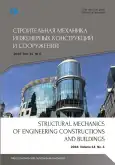Analysis of frame buckling without sidesway classification
- Authors: Galishnikova V.V1, Pahl P.J.2
-
Affiliations:
- Peoples’ Friendship University of Russia (RUDN University)
- Technische Universität Berlin
- Issue: Vol 14, No 4 (2018)
- Pages: 299-312
- Section: Frame buckling
- URL: https://journal-vniispk.ru/1815-5235/article/view/346328
- DOI: https://doi.org/10.22363/1815-5235-2018-14-4-299-312
- ID: 346328
Cite item
Full Text
Abstract
The effective buckling length of a column in a steel frame depends on the sidesway of the frame. The classification sidesway - no sidesway of a frame depends on all members of the frame and is made on an empirical basis. A change of class leads to large changes in the effective column length, and thus affects the buckling load and the economy of the column design. In order to avoid the uncertainties of the empirical classification, it is proposed to determine the buckling load of the complete frame with a nonlinear analysis. The method is illustrated with an unbraced and a braced frame, which are analyzed for hinged as well as fixed columns at ground floor level. The forces in the columns at buckling of the frames are compared to the buckling loads of the single columns. The design of high-rise steel frames against buckling by sidesway - no sidesway categorization has been compared to the buckling analysis of the frames as a whole with nonlinear models. The results confirm the large differences between the buckling loads of braced and unbraced high-rise frames, which are well known from analytical solutions for simple portal frames.
Keywords
About the authors
Vera V Galishnikova
Peoples’ Friendship University of Russia (RUDN University)
Author for correspondence.
Email: galishni@gmail.com
Dr Sci. (Eng.), Professor, Director of the Department of Civil Engineering, Engineering Academy, Peoples’ Friendship University of Russia (RUDN University). Research interests: computational civil engineering, building information modeling, topological computer models of buildings, computational geometry, computational mechanics of complex steel structural systems - latticed plates and shells, thin-walled plate and plate-rod structures, nonlinear finite element analysis of space frames, nonlinear stability of structures
6 Miklukho-Maklaya St., Moscow, 117198, Russian FederationPeter Jan Pahl
Technische Universität Berlin
Email: pahl@ifb.bv.tu-berlin.de
Prof. Dr. Dr. h. c. mult., Department of Civil Engineering, Technical University Berlin (TUB). Research interests: mathematical modeling and optimization of comple, structural systems, computational civil engineering, building information modeling, topological computer models of buildings, computational geometry, computational mechanics of complex steel structural systems - latticed plates and shells, thin-walled plate and platerod structures, nonlinear finite element analysis of space frames, nonlinear stability of structures
17 Juni Str., 135, 10623, Berlin, GermanyReferences
- Pahl P.J. (March 2010). Introduction to the Stability of Frames. Lecture Notes, Stellenbosch University.
- American Institute of Steel Construction. (2017). Steel Construction Manual. 15th Edition. An Online Resourse, www.nxtbook.com/nxtbooks/aisc/steelconstruction manual15thed/index.php?ap=1#/1.
- Ministry of construction and housing and communal services. (2017). SP 26.13330.2017. Steel Structures. Moscow, 140.
- Nazmeeva T.V., Vatin N.I. (2016). Numerical investigations of notched C-profile compressed members with initial imperfections. Magazine of Civil Engineering, (2), 92-101.
- Garifullin M., Bronzova M., Sinelnikov A., Vatin N. (2016). Buckling analysis of cold-formed C-shapes with the new type of perforation. Advances and Trends in Engineering Sciences and Technologies. Proceedings of the International Conference on Engineering Sciences and Technologies, ESaT 2015, 63-68.
- Lalin V.V., Beliaev M.O. (2015). Bending of geometrically nonlinear cantilever beam. Results obtained by Cosserat - Timoshenko and Kirchhoff’s rod theories. Magazine of Civil Engineering, (1), 39-55.
- Lalin V.V., Zdanchuk E.V., Kushova D.A., Rozin L.A. (2015). Variational formulations for non-linear problems with independent rotational degrees of freedom. Magazine of Civil Engineering, (4), 54-65.
- Lalin V.V., Kushova D.A. (2014). New results in dynamic stability problems of elastic rods. Applied Mechanics and Materials, 617, 181-186.
- Agapov V.P. (2015). Comparative analysis of two approaches to modeling rods in the calculation of building constructions with the help of finite element method. Scientific Reviews, (8), 79-86.
- Manuylov G.A., Kosytsyn S.B., Begichev M.M. (2013). Numerical investigation of the stability of elastic fixed arcs. International Journal for Computational Civil and Structural Engineering, 9(1), 78-84.
- Duan L., Chen W.F. (1999). Effective Length Factors of Compression Members, Structural Engineering Handbook. Chen Wai-Fah (Ed.). Boca Raton, CRC Press LLC.
- Galishnikova V., Dunaiski P., Pahl P.J. (2009). Geometrically Nonlinear Analysis of Plane trusses and Frames. Sun Media Stellenbosch.
Supplementary files









